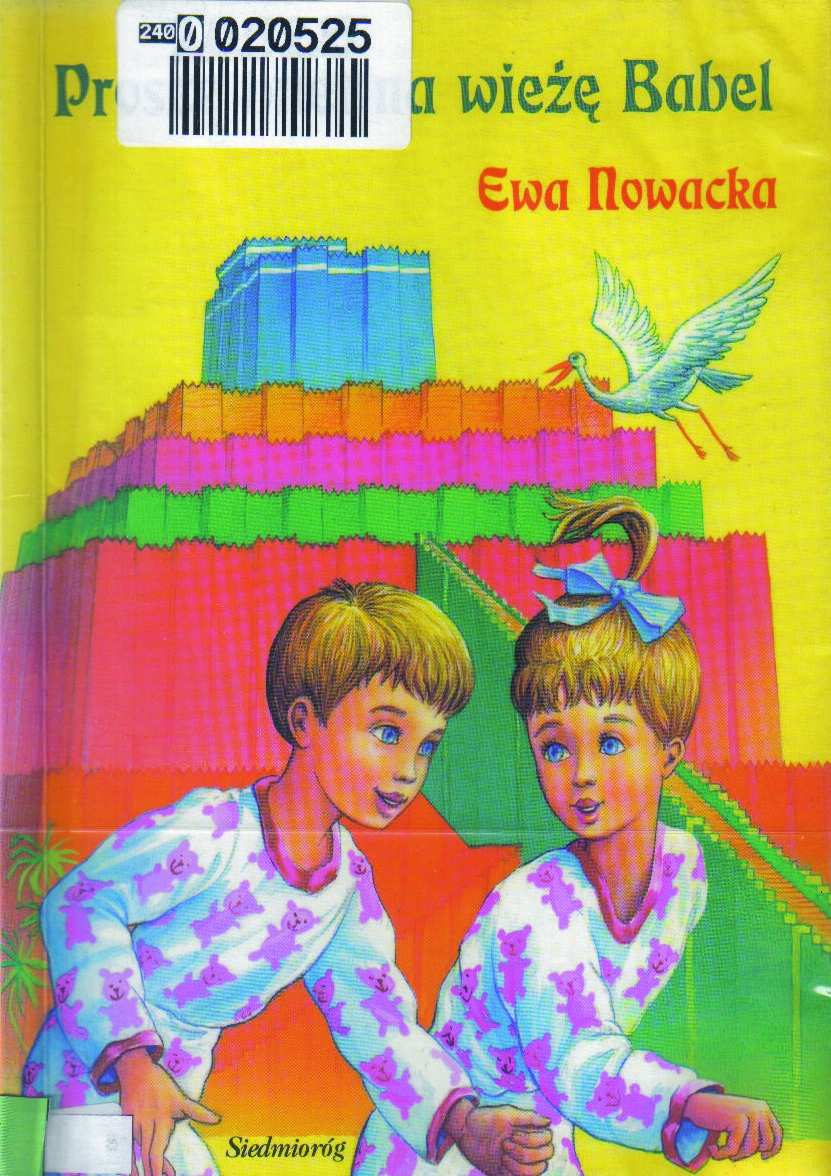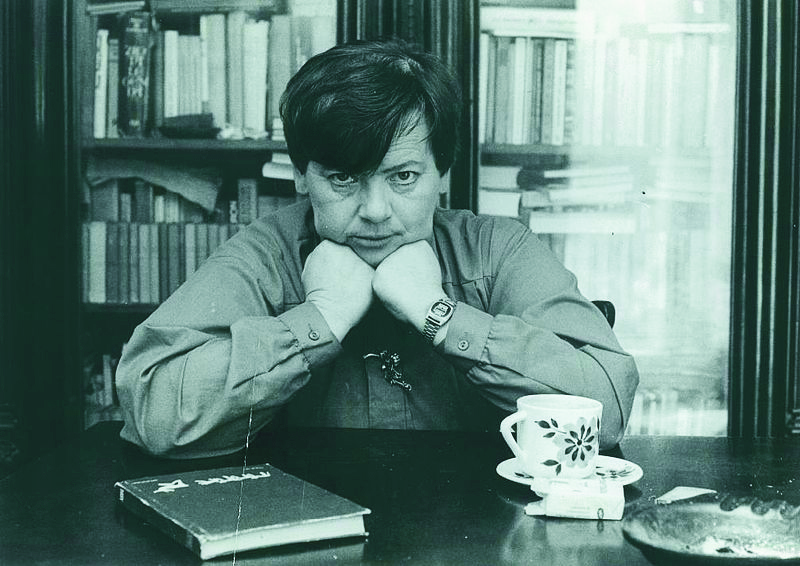Title of the work
Country of the First Edition
Country/countries of popularity
Original Language
First Edition Date
First Edition Details
Ewa Nowacka, Proszę bilet na wieżę Babel. Wrocław: Wydawnictwo Siedmioróg, 1998, 64 pp.
ISBN
Genre
Time-travel fiction
Target Audience
Children
Cover

Cover design and illustrations by Aleksander Karcz. Courtesy of the publisher.
Author of the Entry:
Summary: Barbara Krcha, University of Warsaw, b.krcha@student.uw.edu.pl
Analysis: Marta Pszczolińska, University of Warsaw, m.pszczolinska@al.uw.edu.pl
Peer-reviewer of the Entry:
Katarzyna Marciniak, University of Warsaw, kamar@al.uw.edu.pl
Elżbieta Olechowska, University of Warsaw, elzbieta.olechowska@gmail.com

Ewa Nowacka, photograph by Fzsr, retrieved from Wikimedia Commons (accessed: December 29, 2020).
Ewa Nowacka
, 1934 - 2011
(Author)
A novelist, critic and essayist, winner of numerous national and international awards. For lifetime literary achievement she was awarded Janusz Korczak International Literary Prize, medal of the Polish Section of IBBY, the Commander’s Cross of the Order Polonia Restituta, medal of the Commission of National Education, and the Gloria Artis Medal for Merit for Culture (Gold Class). She wrote about 50 books, mostly for children and adolescents. The author of a bestselling novel Małgosia contra Małgosia [Maggy contra Maggy], 1975, about a 17–year–old heroine living in 20th century Warsaw who is suddenly transported into the 17th century. Nowacka felt at home in Pharaoh’s Egypt, Roman Empire and in modern times. For many years she worked at the Polish Radio and produced many radio-plays for children and young adults.
Sources:
lubimyczytac.pl (accessed: December 29, 2020).
pl.wikipedia.org (accessed: December 29, 2020).
Danuta Świerczyńska-Jelonek, "Różne światy powieści Ewy Nowackiej", Guliwer 3 (2004): 5–13.
[Obituary], PAP [Polish Press Agency], Zmarła autorka popularnych książek dla młodzieży, wiadomosci.wp.pl (accessed: December 29, 2020).
Bio prepared by Sebastian Mirecki, University of Warsaw, smirecki@student.uw.edu.pl
Sequels, Prequels and Spin-offs
Ewa Nowacka, Byk Apis pozdrawia kotkę Pusię, Wrocław: Siedmioróg, 1998.
Ewa Nowacka, Rogi Minotaura, Wrocław: Siedmioróg, 1998.
Ewa Nowacka, Jak okiełznać wronego rumaka, Wrocław: Siedmioróg, 1999.
Summary
Based on: Katarzyna Marciniak, Elżbieta Olechowska, Joanna Kłos, Michał Kucharski (eds.), Polish Literature for Children & Young Adults Inspired by Classical Antiquity: A Catalogue, Faculty of “Artes Liberales”, Warsaw: University of Warsaw, 2013, 444 pp., section by Sebastian Mirecki and Barbara Krcha, pp. 236 and 239.
This is the second book in the series Skrzydła czasu [The Wings of Time]. Three children: Paweł, his brother Janek, and their sister Małgorzata, are travelling through time. They arrive in the ancient city of Babylon and meet historical characters, such as: Nebuchadnezzar, the king of Babylon, and the biblical Daniel, whom lions did not want to devour. They mention also Hercules from the Graeco-Roman mythology. The children see the Hanging Gardens of Babylon, one of the Seven Wonders of the ancient world, as well as a unique system of irrigation invented precisely in the ancient Babylon.
Analysis
The author’s idea of time travel in the first part of the mini-series remains the narrative device allowing contact with Antiquity in part two. This device lets the child reader learn about ancient times and distant cultures simultaneously with the children protagonists in the convention of an adventure story. The protagonist, Paweł, is, this time, transported to ancient Babylon, accompanied by his younger siblings – annoying troublemaker twins. The relations between the siblings are to imitate children’s behaviour. They often offend each other, irritate, disregard or argue, but also take care of each other. Unfortunately, the vocabulary used repeatedly (głupole, kretynki) can be considered improper and offensive rather than funny.
Nowacka sets part of the story in ancient Babylon during the times of Nebuchadnezzar II. This is not her first book set in ancient Mesopotamia (the novel Szubad żąda ofiary [Pu-abi/Shub-Ad Demands a Sacrifice] from 1969 – it was set in Ur and was based on the motif of Sumerian burial tradition). The time travellers are not prepared for the trip, and the younger ones do not even understand how far from home they are. In the beginning, even their more experienced brother does not know where and when they are.
Elements of the ancient world are revealed gradually. At first, the children only feel the natural conditions of the Near East – hot and dry weather. Then, they arrive at the town gate, exactly described as it is exhibited at the Pergamon Museum in Berlin. The illustration depicts the Ishtar Gate as well. In the shadow of the town walls, they get some water and the information that they are in Babylon. Paweł only remembers the name of Babylon in the Biblical context of Noah’s Ark and the Babel Tower. They enter the town at dusk and approach a mountain which appears to be a building made from gigantic bricks. The next “mountain” is also a building – a round tower tapering towards the top. The twins compare it to the Palace of Culture and Science in Warsaw (then the highest building in Poland) and want to look for the nearest McDonalds’. Still, Paweł is amazed that such towers exist and asks himself whether giants live in Babylon, such as the ones that Hercules fought.
Inside the tower, which appears to be a temple, they meet a priest, Szamszi, who uses a device with crystals to observe stars and make astronomical calculations. His profession/occupation is evidently connected to astrology and the knowledge of the future read from the position of the stars. It creates a stereotypical image of a Babylonian priest – a kind of scholar and magus able to reveal the gods’ will, cast a horoscope and/or predict one’s future. Such an attitude, common in Antiquity, is reflected, for example, in Horace’s Ad Leuconoen (…nec Babylonios temptaris numeros). The priest lets them stay, and the kids get to know many people in Marduk’s temple: servants, clairvoyants, diviners, seers and priests and are introduced to the king’s counselor, Daniel. He appears to be the Biblical Daniel, the one thrown into the lions’ den by the ruler (here Nebuchadnezzar, not Darius, which is explained in a footnote).
The kids explore the town, which they compare to Warsaw as they know it. They are disgusted by sacrifice rituals as they sympathize with animals, and surprised that inhabitants believe in magic, try to undo charms, drive out demons, and base their life on horoscopes. They pay attention to the fashion, hairstyles, trade, local dishes, but what attracts them most is the forbidden building consisting of platforms with extraordinary plants. They manage to get inside to visit this secret garden which hides a secret – a living dinosaur. These gardens are an apparent reference to the legendary Hanging Gardens of Babylon, one of the Seven Wonders of the Ancient World listed by Diodorus Siculus.
As Szamszi and Daniel learn that the children travelled through time, they decide to send Paweł to Nebuchadnezzar to tell him about modern devices such as the TV, cars and planes. However, the ruler considers it a lie or a trick, is not interested, and orders to dismiss the boy. Finally, at the top of the tower in the moonlight, the priest draws many lines, starts to mutter incantations and the children can return home. Once there, Paweł checks in his encyclopedia for entries connected with their adventure.
Further Reading
Nowacka, Ewa, Szubad żąda ofiary, Wiersze sumeryjskie z przekł ang. tł. G. T. Lipszyc, il. Grzegorz Rosiński, Warszawa: Nasza Księgarnia, 1969.
Nowacka, Ewa, Biały koń bogów, Warszawa: Nasza Księgarnia, 1973.


